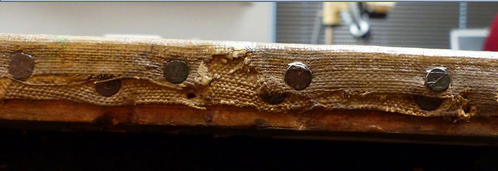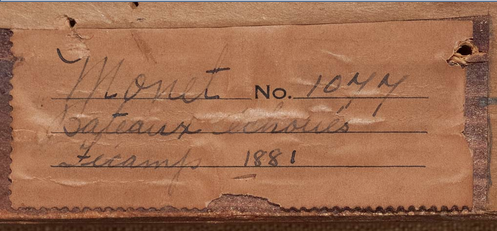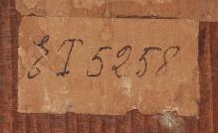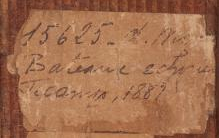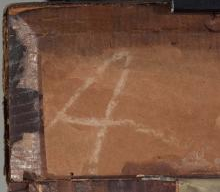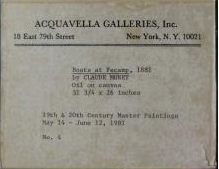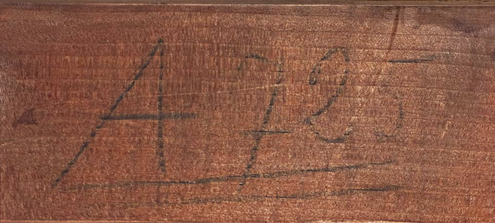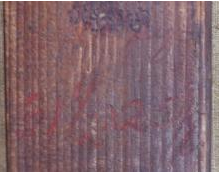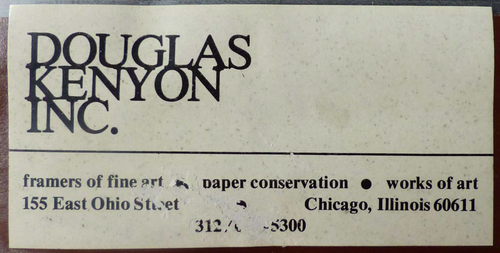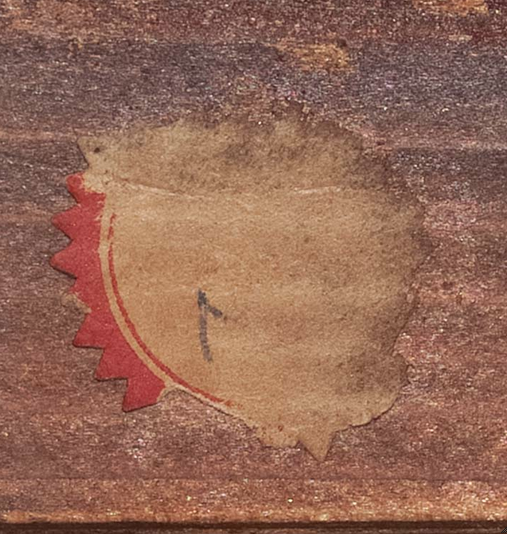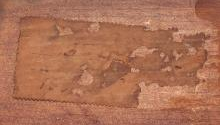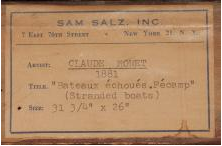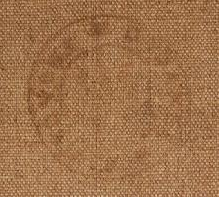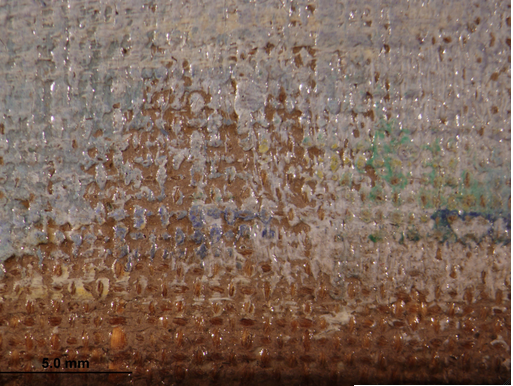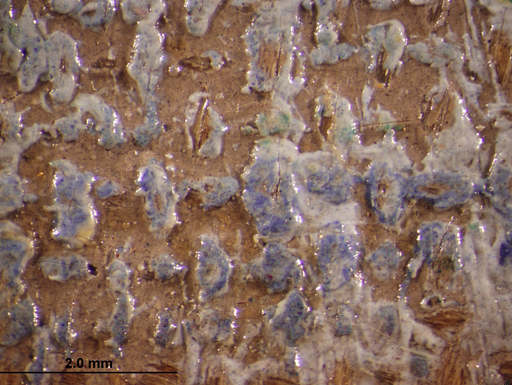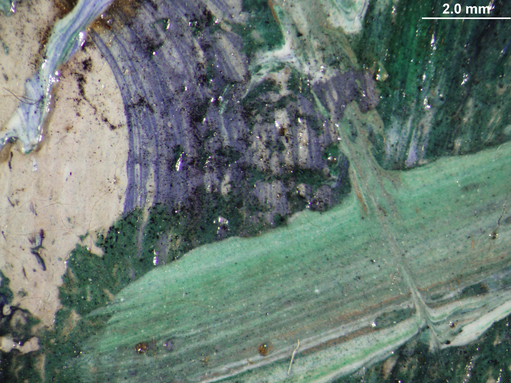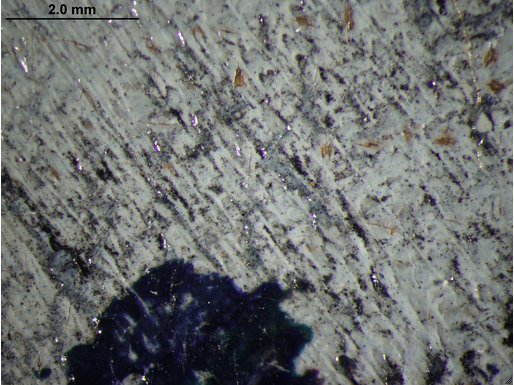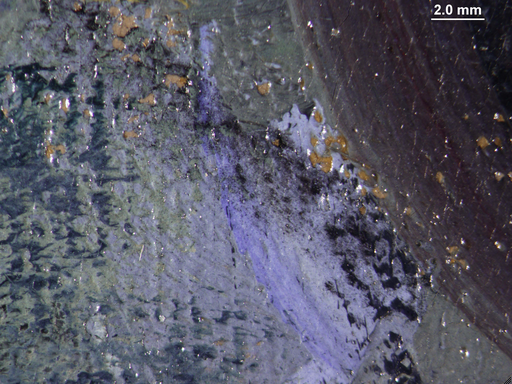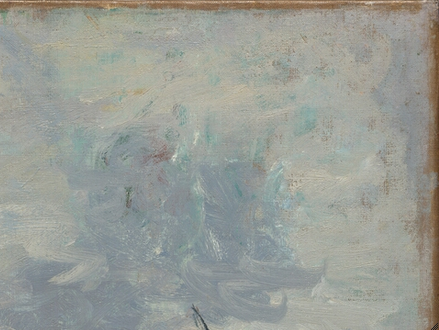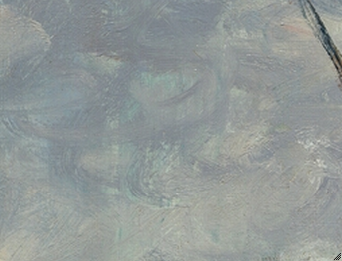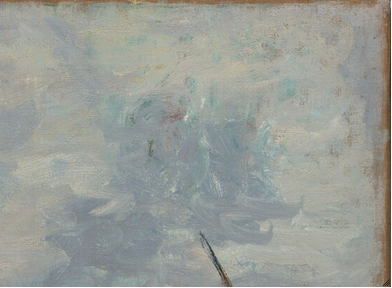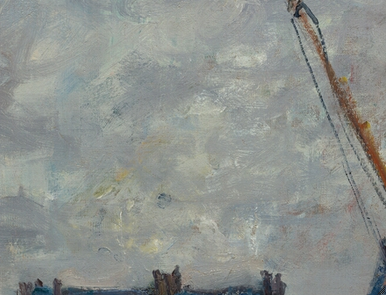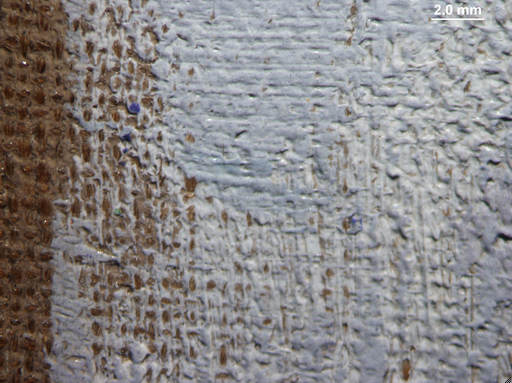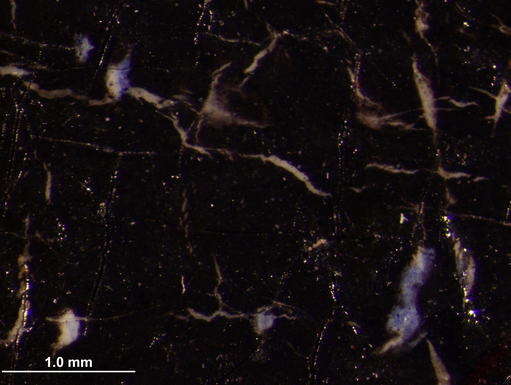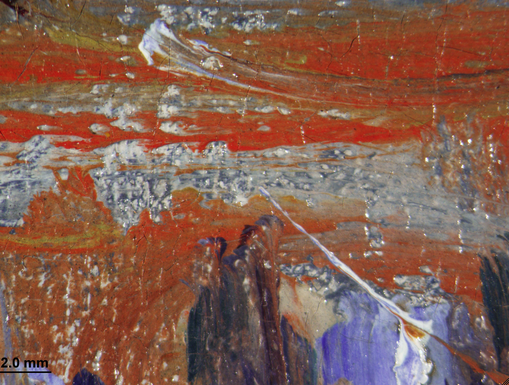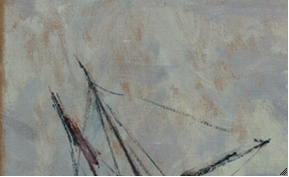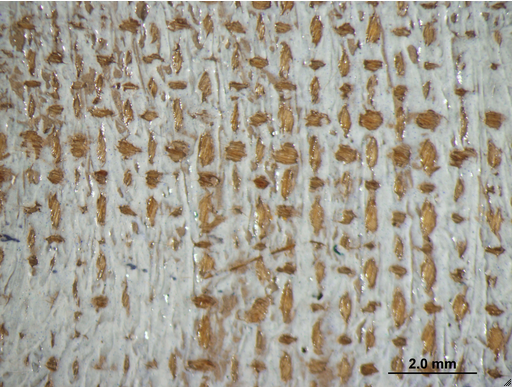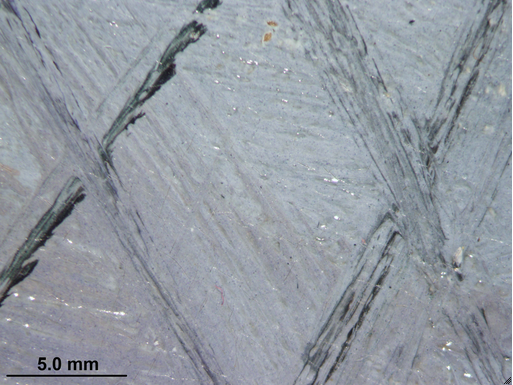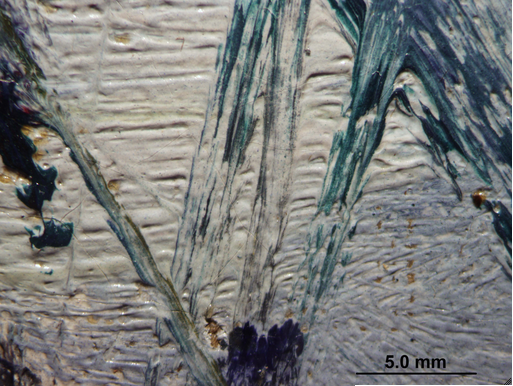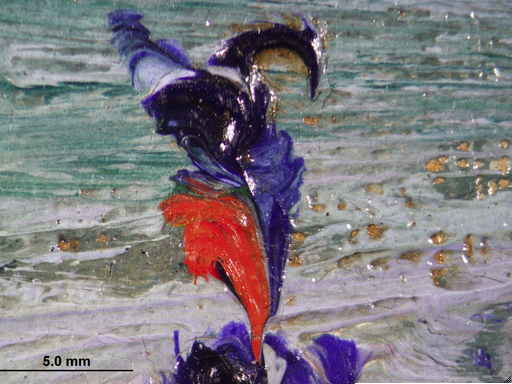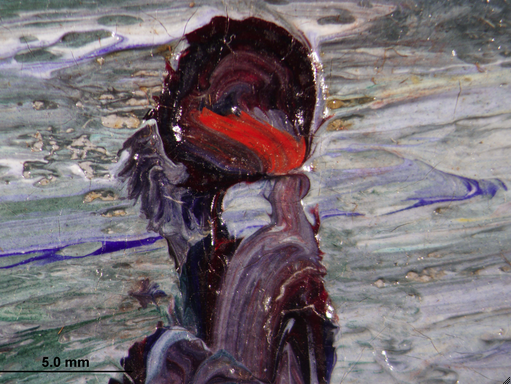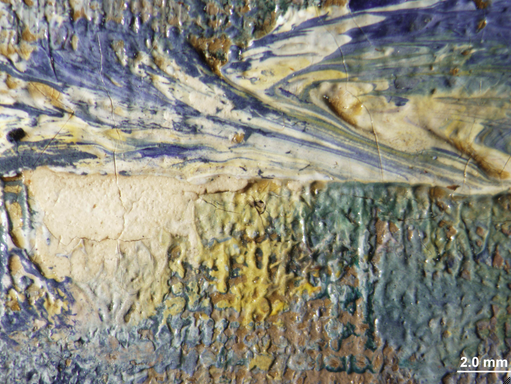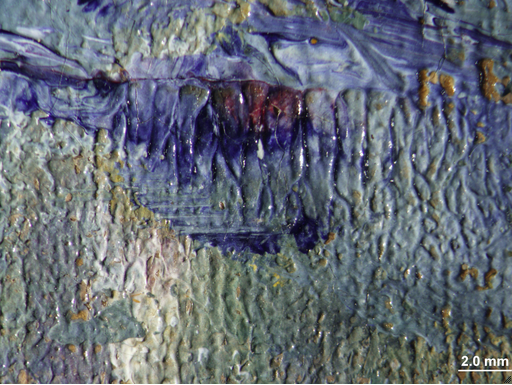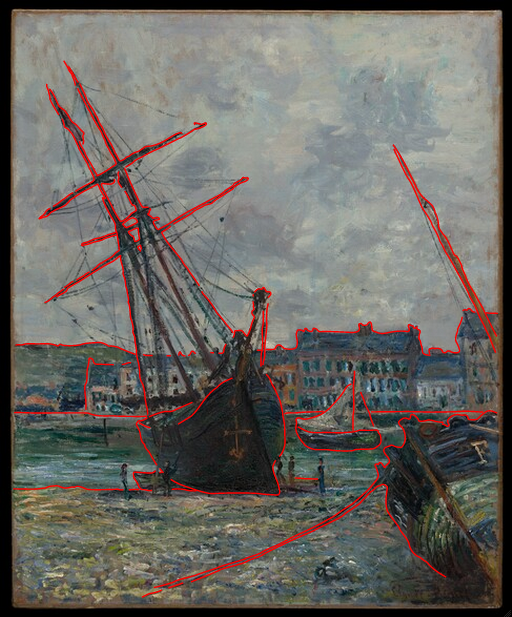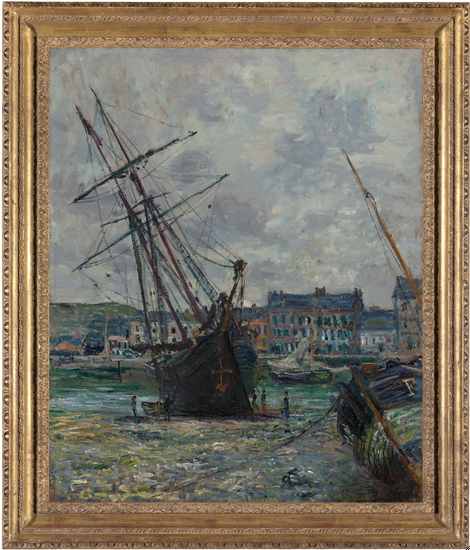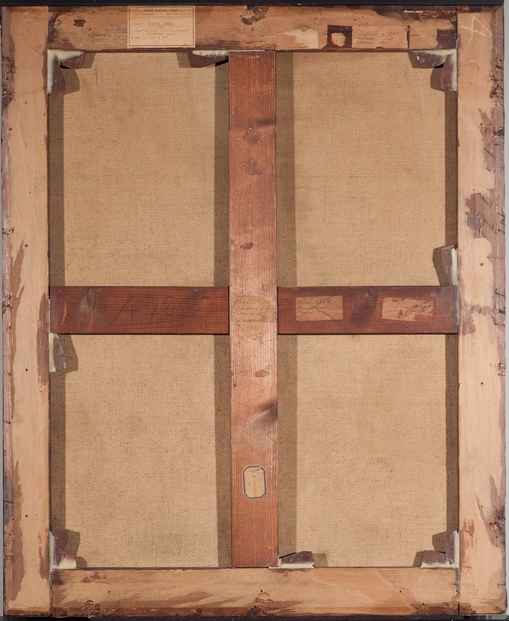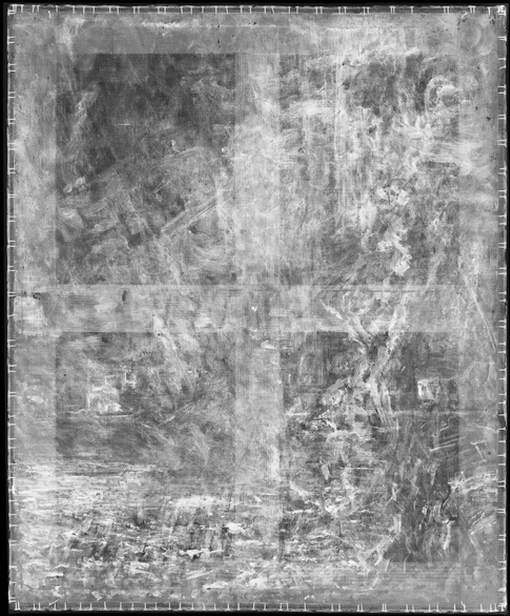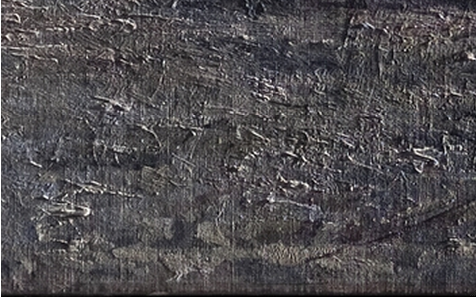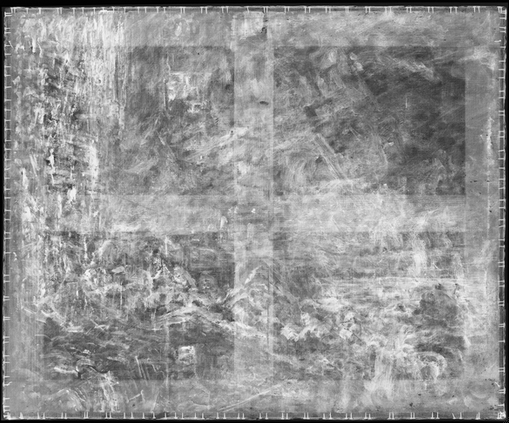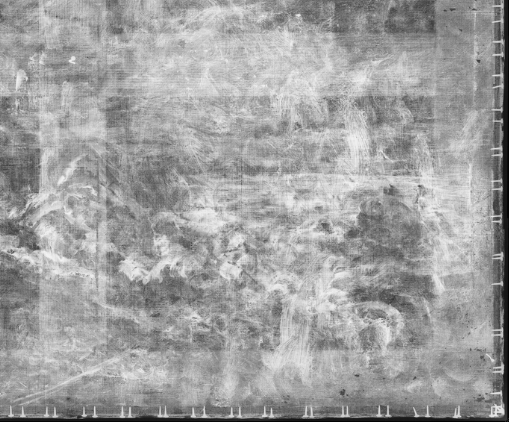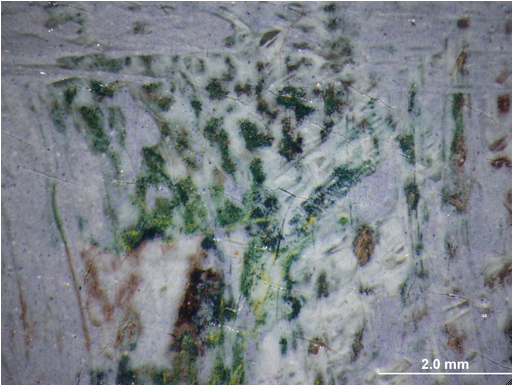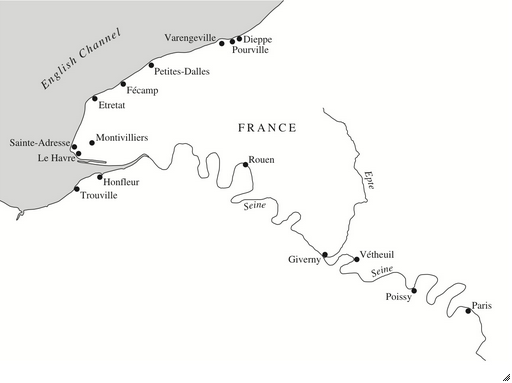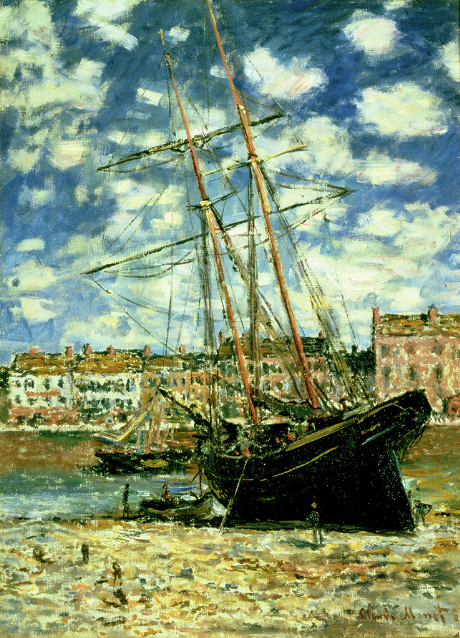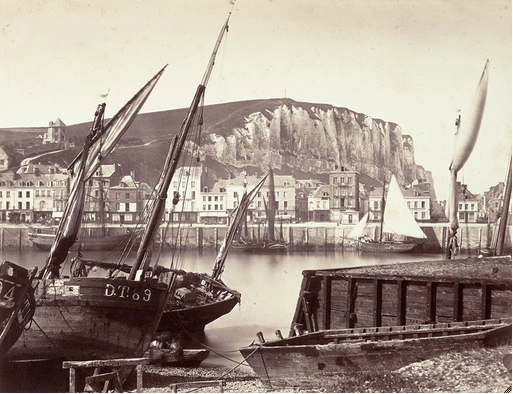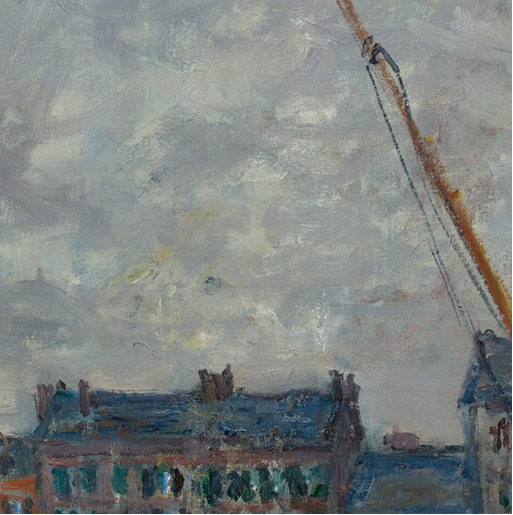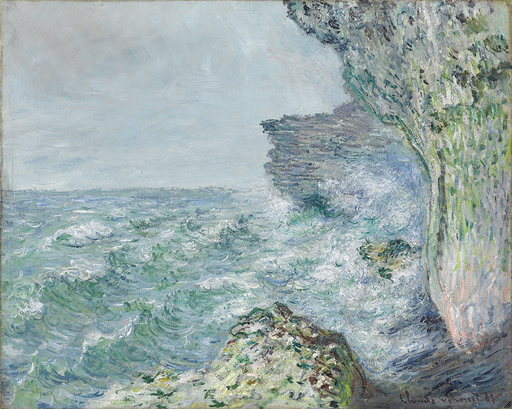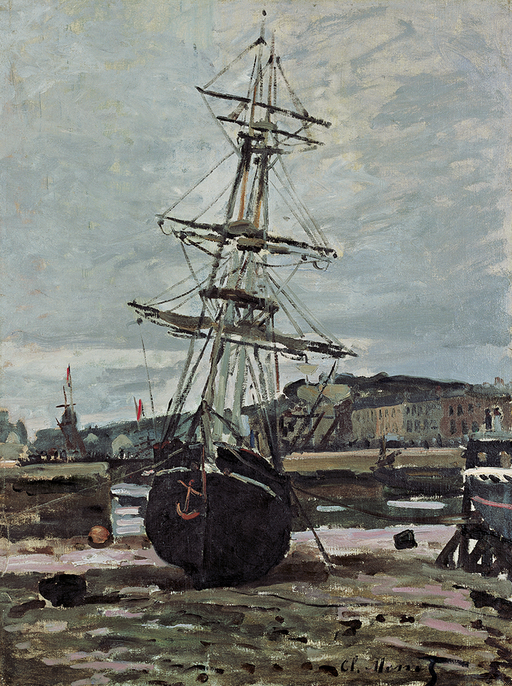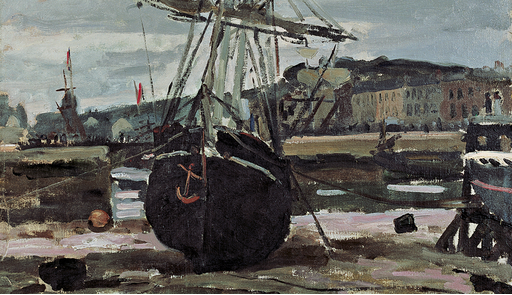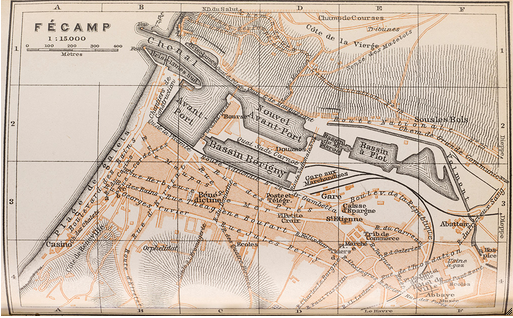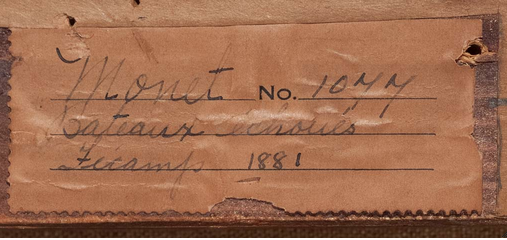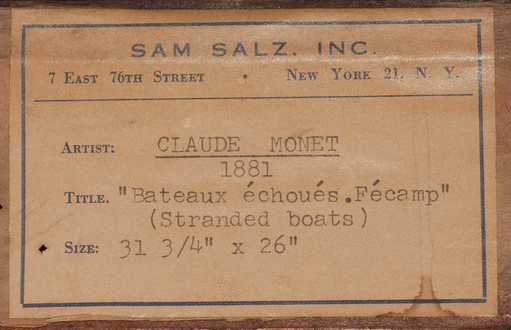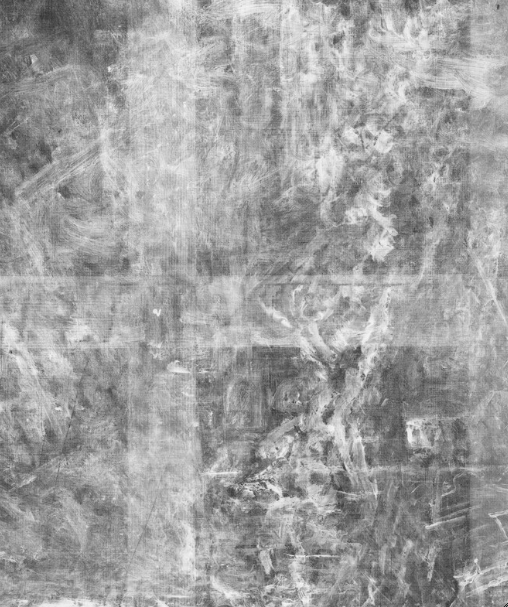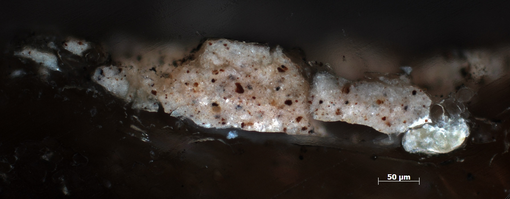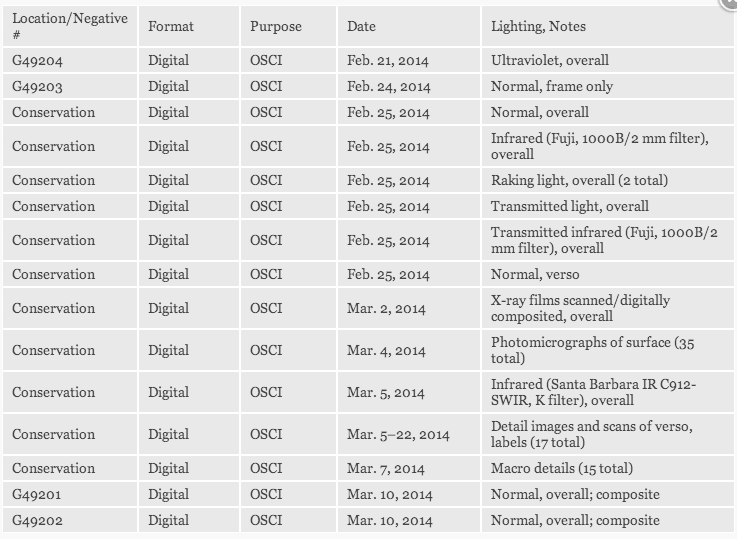Cat. 18
Boats Lying at Low Tide at Fécamp
1881
Oil on canvas; 80.3 × 66 cm (31 5/8 × 26 in.)
Signed and dated: Claude Monet 81 (lower right corner, in dark-red paint)
The Art Institute of Chicago, promised gift of Marian Phelps Pawlick, obj. 222491
Monet’s Boats at Fécamp 1868
The coastal fishing port of Fécamp, ten kilometers from the better-known tourist destination Étretat (fig. 18.1), held particular appeal for Claude Monet. Advantageous in terms of climate and location, Fécamp offered cliffs, jetties, shingle beaches, and a harbor town as subjects. In August 1868, Monet had rented a hotel room in Fécamp for his family and in early September had moved to a rental home. Of the three vertical canvases he painted that summer, two show large sailing ships left stranded by the low tide (e.g., fig. 18.2 [W118]) and are very similar in subject and composition to the two canvases of docked boats executed thirteen years later during a second trip there. Indeed, the compositional elements of the 1868 paintings—sandy beach, a large ship with a prominent anchor, and intricate and finely painted masts tipped to one side—are nearly identical to those of the slightly larger canvases from 1881, the Art Institute painting and Boats Lying at Low Tide at the Tokyo Fuji Art Museum (fig. 18.3 [W644]). Compared with the 1881 compositions, however, the 1868 canvas at the Kunstmuseum Winterthur (fig. 18.2) is moody, with an exaggerated gray tone and a heavy sky. Apart from the red-gold anchor, which drops from the bow and echoes the strip of flag at left and the horizontal stripe on the fragment of a boat hull at far right (fig. 18.4 [W118]), Monet used nearly monochromatic tones for all the harbor elements, employing thick buttery strokes for both the vessel and its surroundings. In the earlier depictions of boats on the beach, Monet’s focus was clearly on the ships. In each of these works there is just a hint of the buildings in the background, whereas in the views of 1881, the patchwork of pink and blue structures plays a prominent role in setting a mood and providing a colorful backdrop for the vessels.
Monet’s Bateaux échoués, Past and Present
The translation of the title of the Chicago painting, Boats Lying at Low Tide at Fécamp, lacks the drama and metaphorical significance of the French title, Bateaux échoués à Fécamp: the adjective “échoués” can mean “failed,” “aborted,” and “unsuccessful,” or in a nautical sense, “stranded,” “aground,” or more literally, “beached.” Popularized by Dutch marine artists in the seventeenth century, the theme of the beached boat was redeployed in the nineteenth century by Romantic and Realist painters, notably Eugène Isabey and Jules Nöel. These painters intensified their pictures of ships in harbors or beached on shores by including figures for narrative effect (e.g., fig. 18.5) or featuring stormy seas or dramatic sunsets in the background. Closely attuned to Monet’s vantage point is a photograph of ships in harbor by Louis-Alphonse Davanne (fig. 18.6), which features ships looming in the foreground, framed on the right by a pier and boat and, beyond the water on the other edge of the harbor, the uniform blocks of the town’s architecture.
What distinguishes these works by Monet from treatments of beached boats by earlier artists and contemporary harbor views by his nearer contemporaries Eugène Boudin and Johan Barthold Jongkind (e.g., fig. 18.7) is the way these seemingly stable compositions are subtly destabilized. In the 1868 painting and both 1881 versions, the careening boat takes center stage with a complicated movement of shifting masts, bowsprits, and rigging. This is quite at odds with the boxlike architecture of the buildings in the background. Monet’s choice of format is also unusual within the tradition of harbor scenes. Instead of the standard marine (by definition, a horizontal), Monet used the portrait, or vertical format, which emphasizes the ship’s towering form and challenges the anticipated frame of reference for the subject.
Fécamp, 1881
On March 9, Monet arrived at Fécamp, leaving his sons with his companion, Alice Hoschédé, and her family at their home in Vétheuil. The artist intended this return trip to the region to last three weeks, but he remained four weeks longer than anticipated, staying with M. Lemarrois on the Grand Quai (fig. 18.8) and on occasion traveling to Petites-Dalles to visit his brother Léon. From the beginning Monet was optimistic about what he would do there, as he reported to his dealer, Paul Durand-Ruel:
I leave tomorrow for Fécamp, where I will make a few seascapes [marines]. As soon as I return—that is in three weeks— I will come to Paris and will bring you the paintings that I need to deliver to you, and at the same time show you what I will have made at the sea.
As the art historian Robert Herbert pointed out, this was an exceedingly productive visit, encouraged and prolonged by the additional funds advanced by Durand-Ruel. In the course of this month Monet painted twenty canvases, including views of the water from the surrounding cliffs at Fécamp and nearby Grainval (e.g., fig. 18.9 [W660]). For both Boats Lying at Low Tide and its related composition at the Tokyo Fuji Art Museum (fig. 18.3 [W644]), Monet placed himself on the shingle beach looking toward the village across the harbor. In the Tokyo version, the ship is turned, profiling the large keel: normally underwater, the keel is now unsettlingly at rest on dry land. Monet’s vantage point was farther away for the Chicago composition, and the ship is foreshortened and seen more straight on. Monet’s inclusion of the hull of a boat at right startles—while it is not the focus of the painting, its leftward slant echoes that of the larger ship, framing the composition in a seemingly random but highly calculated manner. The prominent F on the port side of the bow links the work to another 1868 composition, Boats Lying at Low Tide at Fécamp (1868; private collection [W117]), in which a ship careening helplessly on the sandy shore bears the marking F662 on the hull.
In both 1881 versions, squiggly figures painted wet-on-wet suggest dockhands or shipmen. These figures surround the boat in the Chicago canvas; they hold pole-like objects and appear to be applying caulk, or more likely, removing barnacles and other parasites before the vessel returns to sea (fig. 18.10). Infrared and X-ray imaging reveal what appears to be an earlier, horizontally orientated composition, which means that Monet rotated the canvas ninety degrees for the final, vertical composition. When he abandoned his earlier idea for the present composition, he did not completely scrape down and paint over the original surface. The presence of an underlying composition is most visible in the upper right corner, where traces of blues, ochers, and pinks from another painting show through (fig. 18.11). The sky itself is thinly applied, and touches of light brown from the ground layer are visible in broad areas, indicating that the original composition was not completely painted in but rather drawn in to indicate the basic contours of the landscape or seascape (fig. 18.12). The presence of agitated strokes on the right center to right side, which can be discerned in the X-ray (fig. 18.13), may suggest that these were rocks or even crashing waves. Other paintings completed by the artist that spring, such as The Sea at Fécamp (fig. 18.9 [W660]), included these compositional elements and palette.
The Art Institute Fécamp Exhibited
The dealer Durand-Ruel almost immediately bought up the canvases from Monet’s March–April visit to Fécamp and Petites-Dalles, establishing what Charles Stuckey refers to as “a regularly executed exclusive option” on the artist’s production. The following spring, in 1882, the Art Institute’s Boats Lying at Low Tide at Fécamp was selected by Durand-Ruel as one of thirty-five works to be included in the seventh Impressionist exhibition. Monet wrote to his dealer prior to the opening that he was not convinced it could take place, given that he was unable to be sufficiently involved. Two weeks later Monet expressed further concern about showing his work without having the opportunity to see the other works selected and how they were hung. The Fécamp pictures were Monet’s first recommendation for what Durand-Ruel should choose to include:
Nonetheless and preferably, choose from the paintings that I made in Fécamp. And then [choose from those showing] the ice effects, poppies, fields of wheat, some still lifes, and for the catalogue, put titles that are vague (landscape, seascape) in order to change [them] as needed.
These instructions reveal that it was Monet’s suggestion to provide “vague” titles, thus providing the organizers the flexibility to switch out paintings as necessary. Judging by his correspondence with Durand-Ruel, it is likely that Monet was able to see and select the final works to be included in the exhibition. The Chicago painting was originally exhibited without the qualifier Fécamp in the title. From its first public appearance, a year after it was executed, it retained its more descriptive title, whether the singular Bateau échoué, as it was titled in 1882, or more frequently, when it was shown in several exhibitions at the Durand-Ruel gallery in New York, Bateaux Echoués (see Exhibition History).
At the seventh Impressionist exhibition the Art Institute’s painting was shown with at least three other canvases depicting the view from the cliffs at Fécamp. The critic Nivelle complimented the pictures of cliff views, singling out the Chicago painting as showing “a schooner resting on its flank at low tide with a distant view of the city, seen behind the masts and rigging [agrès].”
The Legacy of Fécamp
Monet would remember Fécamp as a positive experience when compared to the “horrible” Poissy and Dieppe. Boats Lying at Low Tide at Fécamp and, indeed, the works from the 1881 visit in general remain little published in the Monet literature. Part of this reflects the fact that the canvases have remained largely in private hands. When Robert Herbert published his book on Monet in Normandy, for example, he included a black-and-white reproduction of Boats Lying at Low Tide at Fécamp (as Ships Careened in the Harbor of Fécamp). Painted after Monet’s long involvement with the views around Argenteuil and the Seine, both the Chicago and Tokyo (fig. 18.3) canvases represent in some way a nostalgic return to a subject he had experimented with years before. But with these 1881 paintings, he introduced the heightened color and inventive, textural brushwork that would mark his works of the later 1880s. The Chicago painting in particular is deceptively simple in terms of traditional subject matter, but it bears all the hallmarks of Boats on the Beach at Étretat (cat. 22), painted three years later at the popular beach resort town Étretat, where the caloges, or shells of decommissioned boats, offer a counterweight to the otherwise pink-blue sand of the beach and buildings.
Gloria Groom
Technical Report
Technical Summary
Claude Monet’s Boats Lying at Low Tide at Fécamp is painted on a pre-primed, no. 25 portrait (figure) standard-size linen canvas. The ground consists of a highly pigmented, light-brown layer that appears to be quite thin. Technical imaging revealed underlying forms unrelated to the final composition, suggesting that a different composition, likely a horizontal format, was initially painted on the canvas. The earlier composition appears to be an outdoor scene, probably a seascape or landscape. It appears to have been broadly scraped down before the final picture was started, but paint from the first composition remains visible to the naked eye, especially in areas of the right side of the sky, which was very thinly painted. Traces of black particles observed microscopically throughout the painting seem to be related to underdrawing for the final composition as they appear to correspond to elements of that composition, particularly the masts and rigging of the central boat. The final composition appears to have been relatively rapidly executed, consisting largely of an open buildup of wet-on-wet brushstrokes that allows patches of the light-brown ground, as well as small areas of paint from the earlier composition, to show through.
Multilayer Interactive Image Viewer
The multilayer interactive image viewer is designed to facilitate the viewer’s exploration and comparison of the technical images (fig. 18.14).
Signature
Signed and dated: Claude Monet 81 (lower right corner, in dark-red paint) (fig. 18.15, fig. 18.16). The signature and date are very thinly applied and appear abraded in some places. The painting was dry when the signature was applied.
Structure and Technique
Support
Canvas
Flax (commonly known as linen).
Standard Format
The current dimensions correspond closely to a no. 25 portrait (figure) standard-size canvas (81 × 65 cm).
Weave
Plain weave. Average thread count (standard deviation): 16.0V (0.6) × 14.1H (0.5) threads/cm. The horizontal threads were determined to correspond to the warp and the vertical threads to the weft.
Canvas characteristics
There is mild cusping on all four sides.
Stretching
Current stretching: Dates to the aqueous lining (see Conservation History). Tacks spaced 2–4 cm apart. The X-ray shows a second set of tacks underneath the original tacking margins that attaches the edges of the lining canvas to the stretcher; the lining canvas has been trimmed so as not to extend beyond the original tacking edges, but is exposed in a few places (fig. 18.17). Other holes are more recent and appear to be related to something having been screwed into the edges of the stretcher.
Original stretching: Tacks spaced approximately 2–6 cm apart. It appears that several of the original tack holes were reused when the canvas was restretched after lining. Other holes appear to have been crudely filled with a thick, off-white material. Cusping in the canvas corresponds to the placement of the original tack holes.
Stretcher/strainer
Current stretcher: The current stretcher may be original to the painting. It is six membered, including a vertical and a horizontal crossbar, with mortise and tenon joints and twelve keys. Dimensions: Stretcher-bar width, 6.3 cm; stretcher-bar depth, 2.0 cm; crossbar width, 6.2 cm; crossbar depth, 1.5 cm (fig. 18.18).
Original stretcher: See above.
Manufacturer’s/supplier’s marks
None observed in current examination or documented in previous examinations.
Preparatory Layers
Sizing
Not determined (probably glue).
Ground application/texture
The ground extends to the edges of all four tacking margins, indicating that the canvas was cut from a larger piece of primed canvas, which was probably commercially prepared. The ground appears to consist of a single layer (fig. 18.19).
Color
Light brown. Dark-brown and possibly red pigment particles visible microscopically (fig. 18.20, fig. 18.21).
Materials/composition
XRF analysis indicates that the ground contains lead white with calcium compounds and iron oxides including burnt umber, and traces of zinc white and barium sulfate. Binder: Oil (estimated).
Compositional Planning/Underdrawing/Painted Sketch
Extent/character
No underdrawing was observed with infrared reflectography (IRR); however, concentrated areas of black particles—possibly charcoal based on their appearance—were observed microscopically underneath and between the paint layers in several places (fig. 18.22), suggesting that the particles are associated with underdrawing related to the final composition. Very faint lines of the black material closely correspond to the painted lines of the masts and rigging of the central ship, indicating that these lines were lightly drawn in prior to the application of the paint (fig. 18.23). Black particles were also observed in many places underneath the buildings and the boat in the lower right corner. In one area, a visible line conforms somewhat to the side of this boat and appears to continue underneath the edge of it (fig. 18.24).
Medium/technique
Not analyzed.
Revisions
Where sufficient material was present to discern actual drawing lines, these lines appear to correspond closely to elements of the final composition.
Paint Layer
Application/technique and artist’s revisions
Close observation of the painting surface reveals several areas of colorful brushwork underneath the sky that are unrelated to the final composition. The technical images confirm that a different composition was initially painted on the canvas. X-ray and infrared images show a dominant vertical feature in the right side of the sky (fig. 18.25) that seems to suggest that the earlier composition was painted with the canvas rotated 90 degrees clockwise. With the canvas turned on its side, the dominant vertical feature—now oriented horizontally—is positioned approximately one-third of the way up from the bottom edge and appears to represent a horizon line or shoreline (fig. 18.26). The long, rather straight brushstrokes associated with this feature, which are visible in the X-ray and infrared images, appear to be associated with a thin, light-green paint (fig. 18.27, fig. 18.28). With the canvas still rotated horizontally, the X-ray shows undulating brushwork in what is now the lower left corner that seems to be related to the presumed horizon or shore line (possibly rough waves or rocks). On the right side of this “landscape” orientation are two specific forms visible in the X-ray and infrared images—one near the center and one near the “right” edge—that appear to represent rocks or other landscape features (fig. 18.29). In both areas, colorful paint is exposed at the surface where it was only partially covered by the sky in the final composition (fig. 18.30, fig. 18.31). Green, brown, yellow, and dark-blue paint can be discerned, although the paint appears to be very thin and abraded, possibly having been scraped or wiped away before the final composition was begun (fig. 18.32). The earliest paint layer in the sky on the left half of the final (vertical) painting could also be from the first composition. It is very thin, with exposed ground throughout. The strokes are mainly vertically oriented and seem to trail off the top edge of the canvas. There are long continuous strokes running parallel to the left edge (fig. 18.33); they seem to be oriented in a way that would be expected if the canvas was painted in a horizontal orientation.
Other elements that appear to have been part of the earlier composition include some roughly vertical strokes in the foreground water, visible in the X-ray and raking-light images; the orientation of these strokes runs counter to the general buildup of the foreground, which was painted using mostly horizontal strokes (fig. 18.34). Drying cracks in the dark-brown paint of the hull of the central boat reveal white and light-blue paint that could be related to sky or water from the underlying composition (fig. 18.35). Thin, broken layers of bluish-gray and greenish-gray paint are visible underneath the small sailboat and the buildings behind it (fig. 18.36). These gray layers are probably part of the original composition and appear to have been scraped down (fig. 18.37). The fact that so much of the light-brown ground layer remains exposed throughout the painting, especially in the sky (fig. 18.38)—where elements of the first composition are most evident—seems to indicate that either the earlier composition was not very advanced, and remained sketchy around the periphery, or, as mentioned above, that the earlier composition was broadly scraped away or otherwise abraded before the final painting was begun. In the lower left quadrant of the X-ray, some long, fine scratches are visible that could be evidence of scraping with a rigid tool (fig. 18.39). In addition, there are numerous areas throughout the painting where the ground, exposed through breaks in the brushwork of the final composition, is abraded, exposing the peaks of the canvas threads (fig. 18.40).
The final composition is openly painted, leaving exposed at the surface areas of ground, as well as some of the brushwork from the earlier composition. The painting appears to have been relatively rapidly executed with much of the brushwork applied wet-on-wet. The buildup of the sky consists of strokes in a variety of shades ranging from pale gray to dark gray, applied in random orientations, mostly wet-on-wet (fig. 18.41). The buildings, water, and foreground consist largely of individual strokes and touches applied wet-on-wet using a variety of colors. The artist used longer, horizontal strokes to denote the water in the middle distance, whereas the foreground was painted using shorter strokes and touches applied in different orientations. Multiple colors were often picked up on the brush without mixing (fig. 18.42). The rigging of the central boat was painted with a dry brush lightly dragged across the surface. The lines were pulled wet-in-wet through one another where they intersect (fig. 18.43) and through the thicker impasted strokes of the sky when they were still wet (fig. 18.44). The five small figures positioned around the central boat were painted wet-in-wet over the background, using a few deft strokes of the brush (fig. 18.45, fig. 18.46).
There is a band of disturbed paint at approximately 2.5 cm from the bottom edge where something was pressed against the wet surface (fig. 18.47, fig. 18.48), possibly from an easel or traveling crate used when the painting was still wet. There is also some flattened paint around the edges that appears to have been caused by framing when the paint was still soft.
Painting tools
Brushes including 0.3–0.5 and 1 cm width, flat ferrule (based on width and shape of brushstrokes). Several brush hairs are embedded in the paint layer.
Palette
XRF analysis indicates the presence of the following pigments: lead white, chrome yellow, iron oxides including burnt umber, vermilion, emerald green, viridian, cobalt blue, and bone black. When the painting surface was examined under UV, several light-pink brushstrokes exhibited a pinkish fluorescence, suggesting the use of red lake; microscopic examination of the painting surface suggests that another deep-red, nonfluorescing lake was also used.
Binding media
Oil (estimated).
Surface Finish
Varnish layer/media
The painting has an even, slightly glossy surface coating (synthetic resin estimated). There are residues of yellowed natural-resin varnish in the interstices of the brushwork.
Conservation History
There are no records of previous conservation treatment on file. The painting has been lined with an aqueous adhesive. The original stretcher appears to have been retained. The tacking margins have been trimmed and tacked to the stretcher independent of the original tacking edges. There are many small flake losses, mainly at the edges and corners that have previously been consolidated, filled, and retouched, probably in more than one campaign. The presence of yellowed natural-resin residues in the recesses of the paint texture indicates that the work was cleaned at least once prior to the application of the current synthetic varnish.
Condition Summary
The painting is in good condition. The painting is lined with an aqueous adhesive and appears to retain its original stretcher. The canvas is somewhat slack and has an overall convex bulge. Abrasion of paint and ground layers throughout the work appears to be part of the artist’s working process, probably related to scraping down of the earlier composition. There are numerous small flake losses, down to the canvas; these are concentrated mainly near the edges and corners. Some areas appear to have been consolidated with a wax-based adhesive that has discolored. Several of these losses have been filled and retouched; some of the retouching is poorly matched to the original paint. There are localized areas of drying cracks in dark areas including the hull of the central boat, the sailboat, and parts of the buildings. There are fine mechanical cracks scattered throughout the paint layer that are mostly visible only under magnification. Several brush hairs are embedded in the paint layer. The painting has a somewhat glossy varnish layer, and there are residues of yellowed natural-resin varnish in the recesses of the paint texture. There are a few tiny accretions scattered over the surface, including wax residues from past consolidation and paint splatters.
Kimberley Muir
Frame
The current frame is not original to the painting. It is an American, mid-to-late-twentieth-century, stylized reproduction of an Italian, seventeenth-century, Carlo Maratta, scotia frame with a leaf-and-tongue sight molding (APF Inc., New York). The frame is water gilded over red-brown bole on gesso. The gilding is selectively burnished and heavily rubbed and toned. A final whitish-raw umber tone was washed over the frame and flecked overall in white. The carved basswood molding is mitered and nailed, and a pine back frame was nailed and glued to the moldings. The molding, from perimeter to interior, is ovolo with carved egg-and-flower ornament; scotia side; convex; torus with carved ribbon-and-reel ornament; scotia; ogee with carved leaf-and-tongue ornament (fig. 18.49).
Kirk Vuillemot
Provenance
Sold by the artist, to Durand-Ruel, Paris, May 1881.
Acquired by M. Michaut, by Mar. 23, 1888.
Sold by M. Michaut to Durand-Ruel, Paris, Mar. 23, 1888.
Transferred from Durand-Ruel, Paris, to Durand-Ruel, New York, 1888.
Sold by Durand-Ruel, New York, to Alfred Atmore Pope, Cleveland, Dec. 14, 1892.
Sold by Alfred Atmore Pope, Cleveland, to Durand-Ruel, New York, Mar. 3, 1893.
Sold by Durand-Ruel, New York, to Edwin C. Vogel, New York, Oct. 10, 1947.
Acquired by Mr. and Mrs. Charles Goldman, New York, by Sept. 25, 1957.
Acquired by Sam Salz, New York, by Mar. 22, 1981.
Acquired by a private collector, United States, by May 14, 1981.
Sold at Sotheby’s, New York, Nov. 5, 1981, lot 183, to [unknown].
Acquired by Allan Frumkin, Chicago and New York, by 1982.
Sold by Allan Frumkin, Chicago and New York, to Mrs. Marian Phelps Pawlick, in 1982.
Exhibition History
Paris, 251, rue Saint-Honoré, Salons du Panorama de Reischoffen, 7me exposition des artistes indépendants [Seventh Impressionist exhibition], Mar. 1–31, 1882, cat. 64, as Bateau échoué.
New York, Durand-Ruel Galleries, Exposition of Forty Paintings by Claude Monet, Jan. 12–27, 1895, cat. 23, as Bateaux Echoués, 1881.
New York, Durand-Ruel Galleries, Paintings by Claude Monet, Jan. 26–Feb. 14, 1907, cat. 11, as Bateaux échoués, 1881.
New York, Durand-Ruel Galleries, Paintings by Claude Monet, Dec. 2–23, 1911, cat. 9.
New York, Durand-Ruel Galleries, Paintings by Claude Monet, Mar. 7–21, 1914, cat. 8, as Bateaux échoués, Fécamp, 1881.
San Francisco, Panama-Pacific International Exposition, Feb. 20–Dec. 4, 1915, cat. 2813, as Bateaux echoues, Fecamp.
New York, Durand-Ruel Galleries, Paintings by Claude Monet, commencing Mar. 8, 1923, cat. 3, as Bateaux échoués, Fécamp, 1881.
New York, Durand-Ruel Galleries, Retrospective Exhibition of Paintings by Claude Monet, 1840–1926, Jan. 8–29, 1927, cat. 10.
Philadelphia, The Art Club, Memorial Exhibition of the Works of Cl. Monet, April 4–23, 1927, cat. 33.
Paris, Musée de l’Orangerie, Claude Monet: Exposition rétrospective, 1931, cat. 48.
London, Arthur Tooth and Sons, Selected Pictures by Claude Monet (1840–1926), Mar. 12–Apr.4, 1936, cat. 20.
St. Louis, City Art Museum of St. Louis, Claude Monet: A Loan Exhibition, Sept. 25–Oct. 22, 1957, cat. 49 (ill.); Minneapolis, Minneapolis Institute of Arts, Nov. 1–Dec. 1, 1957.
New York, Wildenstein, “One Hundred Years of Impressionism:” A Tribute to Durand-Ruel, Apr. 2–May 9, 1970, cat. 50 (ill.).
New York, Acquavella Galleries, 19th and 20th Century Master Paintings, May 14–June 12, 1981, cat. 4 (ill.).
Selected References
Catalogue de la 7me exposition des artistes indépendants, exh. cat. (Morris pére et fils, 1882), cat. 64.
La Fare, “Exposition des impressionnistes,” Le gaulois (Mar. 2, 1882), p. 2.
Jean de Nivelle, “Les peintres indépendants,” Le soleil, Mar. 4, 1882, pp. 1–2. Reprinted in Ruth Berson, ed., The New Painting: Impressionism, 1874–1886, Documentation, vol. 1, Reviews (Fine Arts Museums of San Francisco/University of Washington Press, 1996), pp. 406–07.
Durand-Ruel Galleries, New York, Exposition of Forty Paintings by Claude Monet, exh. cat. (Durand-Ruel, 1895), cat. 23.
Durand-Ruel Galleries, New York, Exhibition of Paintings by Claude Monet, exh. cat. (Durand-Ruel, 1907), cat. 11.
Durand-Ruel Galleries, New York, Exhibition Paintings by Claude Monet, exh. cat. (Durand-Ruel, 1914), cat. 8.
John E. D. Trask and J. Nilsen Laurvik, eds., Catalogue de Lux of the Department of Fine Arts, Panama-Pacific International Exposition, exh. cat. vol. 1 (Paul Elder, 1915), p. 204, cat. 2813.
Durand-Ruel Galleries, Exhibition of Paintings by Claude Monet, exh. cat. (Durand-Ruel, 1923), cat. 3.
Durand-Ruel Galleries, Retrospective Exhibition of Paintings by Claude Monet, 1840–1926, exh. cat. (Durand-Ruel Galleries, 1927), cat. 10.
Arthur Tooth & Sons, Important Exhibition, Selected Pictures by Claude Monet (1840-1926), exh. cat. (Pelican Press, 1936), cat. 20.
Claude Monet: A Loan Exhibition, exh. cat. (Minneapolis Society of the Fine Arts, 1957), p. 62, cat. 49 (ill.).
William C. Seitz, “Claude Monet’s View of Nature,” in Claude Monet: A Loan Exhibition, exh. cat. (Minneapolis Society of the Fine Arts, 1957), p. 21.
“One Hundred Years of Impressionism:” A Tribute to Durand-Ruel, preface by Florence Gould, exh. cat. (Wildenstein, 1970), pl. 50.
Daniel Wildenstein, Claude Monet: Biographie et catalogue raisonné, vol. 1, Peintures, 1840–1881 (Bibliothèque des Arts, 1974), pp. 117; 392; 393, cat. 645 (ill.).
Acquavella Galleries, 19th and 20th Century Master Paintings: Exhibition, exh. cat. (Acqauvella Galleries, 1981), pp. 12–13, cat. 4 (ill.).
Charles S. Moffett, ed., The New Painting: Impressionism, 1874–1886, exh. cat. (Fine Arts Museums of San Francisco, 1986), pp. 394, 395.
Daniel Wildenstein, Claude Monet: Catalogue raisonné, vol. 5, Supplément aux peintures: Dessins; Pastels; Index (Wildenstein Institute, 1991), p. 35.
Robert L. Herbert, Monet on the Normandy Coast: Tourism and Painting, 1867–1886 (Yale University Press, 1994), p. 39, fig. 40.
Ruth Berson, ed., The New Painting: Impressionism, 1874–1886, Documentation, vol. 1, Reviews (Fine Arts Museums of San Francisco/University of Washington Press, 1996), pp. 377, 400, 406.
Ruth Berson, ed., The New Painting: Impressionism, 1874–1886, Documentation, vol. 2, Exhibitied Works (Fine Arts Museums of San Francisco/University of Washington Press, 1996), pp. 205, 220 (ill.).
Daniel Wildenstein, Monet, or The Triumph of Impressionism, cat. rais., vol. 1 (Taschen/Wildenstein Institute, 1996), p. 166.
Daniel Wildenstein, Monet: Catalogue raisonné/Werkverzeichnis, vol. 2, Nos. 1–968 (Taschen/Wildenstein Institute, 1996), pp. 244, cat. 645 (ill.); 245.
Eric M. Zafran, “Monet in America,” in Wildenstein and Co., Claude Monet (1840–1926): A Tribute to Daniel Wildenstein and Katia Granoff, exh. cat. (Wildenstein, 2007), p. 92.
Other Documentation
Documentation from the Durand-Ruel Archives
Inventory number
Stock Durand-Ruel Paris 1459
Durand-Ruel, Paris, stock book 1880–84, and stock book Dec. 31, 1884.
Inventory number
Stock Durand-Ruel New York 368
Inventory number
Stock Durand-Ruel New York 1077
Photograph number
Photo Durand-Ruel no. A725
Other Documents
Label (fig. 18.50)
Label (fig. 18.51)
Inscription (fig. 18.52)
Documentation from the Sam Salz Archive
Label (fig. 18.53)
Labels and Inscriptions
Undated
Label
Location: stretcher
Method: handwritten script on printed label
Content: Monet No. 1077 / Bateaux échoués / Fécamp 1881 (fig. 18.54)
Label
Location: stretcher
Method: handwritten script
Content: Monet. 13487 / Bateaux echoués, / Fécamp, 1881. (fig. 18.55)
Label
Location: stretcher
Method: handwritten script
Content: 15625. Cl. Mo[net?] / Bateaux echou[és] / Fecamp, 1881 (fig. 18.56)
Label
Location: stretcher
Method: handwritten script
Content: [M?] Ruel / 37 A. Friedland / 20 (fig. 18.57)
Label
Location: stretcher
Method: typewritten script on printed label
Content: SAM SALZ. INC. / 7 EAST 76TH STREET • NEW YORK 21, N. Y. / ARTIST: CLAUDE MONET / 1881 / TITLE. “Bateaux échoués.Fécamp” / (Stranded boats) / SIZE: 31 3/4" × 26" (fig. 18.58)
Label
Location: stretcher
Method: handwritten script
Content: [EI?]5258 (fig. 18.59)
Label
Location: stretcher
Method: handwritten script
Content: [?] (fig. 18.60)
Label
Location: stretcher
Method: handwritten script on printed label
Content: [?] / [?] / [?] (fig. 18.61)
Label
Location: mylar backing
Method: typewritten script on printed label
Content: ACQUAVELLA GALLERIES, Inc. / 18 East 79th Street / New York, N. Y. 10021 / Bateaux Echoues A Fecamp, 1881 / (Boat at Fecamp) / by CLAUDE MONET / Oil on canvas / 21 [sic] 3/4 × 26 inches (fig. 18.62)
Label
Location: mylar backing
Method: printed label
Content: DOUGLAS / KENYON / INC. / framers of fine art • paper conservation • works of art / 155 East Ohio Street • Chicago, Illinois 60611 / 312/[. . .]-5300 (fig. 18.63)
Stamp
Location: lining canvas
Method: stamp
Content: [?] (fig. 18.64)
Inscription
Location: stretcher
Method: handwritten script
Content: A (fig. 18.65)
Inscription
Location: stretcher
Method: handwritten script
Content: B[?]44 3 Mon Fecamp (fig. 18.66, fig. 18.67)
Inscription
Location: stretcher
Method: handwritten script
Content: A725 (fig. 18.68)
Inscription
Location: stretcher
Method: handwritten script
Content: [?] / 31 1/2 × 25 [7/8?] (fig. 18.69)
Post-1980
Label
Location: mylar backing
Method: typewritten script on printed label
Content: ACQUAVELLA GALLERIES, Inc. / 18 East 79th Street New York, N. Y. 10021 / Boats at Fecamp, 1881 / by CLAUDE MONET / Oil on canvas / 31 3/4 × 26 inches / 19th & 20th Century Master Paintings / May 14–June 12, 1981 / No. 4 (fig. 18.70)
Examination and Analysis Techniques
X-radiography
Westinghouse X-ray unit, films scanned on Epson Expressions 10000XL flatbed scanner. Scans digitally composited by Robert G. Erdmann, University of Arizona.
Infrared Reflectography
IRCameras of Santa Barbara IRC912-SWIR with K filter (2.1–2.4 µm); Fujifilm S5 Pro with X-Nite 1000B/2 mm filter (1.0–1.1 µm); and Goodrich/Sensors Unlimited SU640SDV-1.7RT with H filter (1.1–1.4 µm), J filter (1.5–1.7 µm).
Transmitted Infrared
Fujifilm S5 Pro with X-Nite 1000B/2 mm filter (1.0–1.1 µm).
Visible Light
Natural-light, raking-light, and transmitted-light overalls and macrophotography: Fujifilm S5 Pro with X-NiteCC1 filter.
High-Resolution Visible Light (and Ultraviolet)
Sinar P3 camera with Sinarback eVolution 75 H (PECA 918 UV/IR interference cut filter and B+W UV 010 MRC F-Pro filter).
Microscopy and Photomicrographs
Sample and cross-sectional analysis using a Zeiss Axioplan2 research microscope equipped with reflected light/UV fluorescence and a Zeiss AxioCam MRc5 digital camera. Types of illumination used: darkfield, differential interference contrast (DIC), and UV. In situ photomicrographs with a Wild Heerbrugg M7A StereoZoom microscope fitted with an Olympus DP71 microscope digital camera.
X-ray Fluorescence Spectroscopy (XRF)
Several spots on the painting were analyzed in situ with a Bruker/Keymaster TRACeR III-V with rhodium tube.
Automated Thread Counting
Thread count and weave information were determined by Thread Count Automation Project software.
Image Registration Software
Overlay images registered using a novel image-based algorithm developed by Damon M. Conover (GW), John K. Delaney (GW, NGA), and Murray H. Loew (GW) of the George Washington University’s School of Engineering and Applied Science and the National Gallery of Art, Washington, D.C.
Image Inventory
The image inventory compiles records of all known images of the artwork on file in the Conservation Department, the Imaging Department, and the Department of Medieval to Modern European Painting and Sculpture at the Art Institute of Chicago (fig. 18.71).

